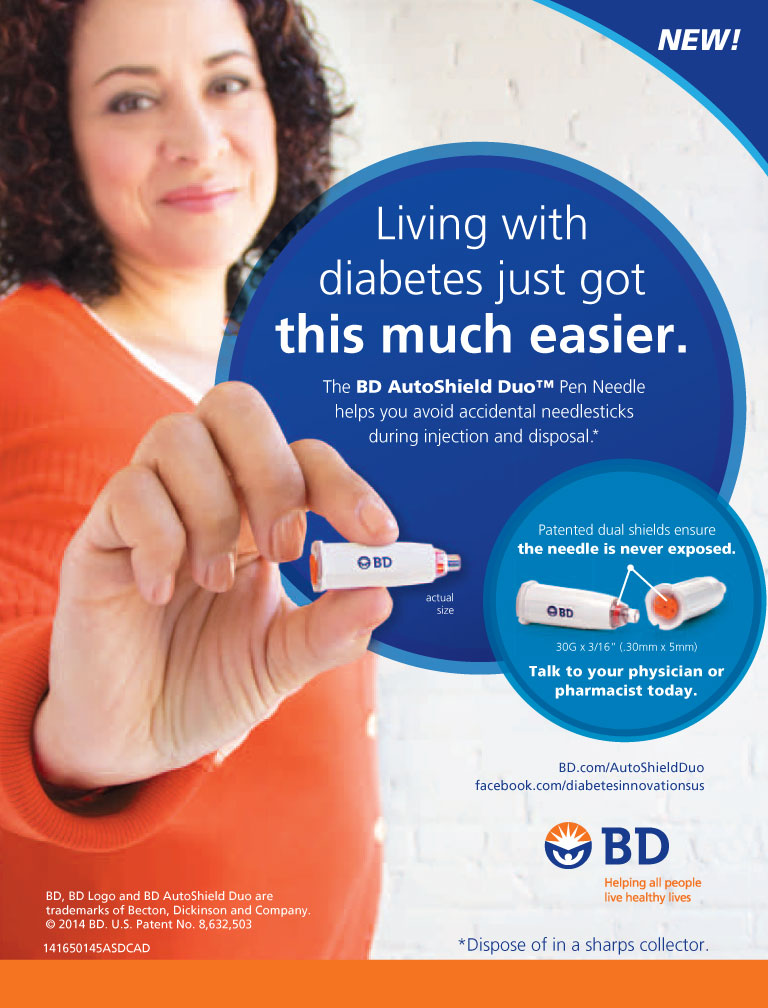
One of the hardest things?about living with diabetes?is making changes in your?eating and exercise habits.?Knowing the things you?need to do—and even?wanting to do them—may?not always be enough to?make them happen. A recent?study focused on behavior?change may have some keys?that can be helpful in?your life. The study examined?something called the self-determination?theory.?According to that theory,?there are three basic needs?that help us to start and?maintain healthy behaviors: 1. A need for feeling?like we determine?and control our own?behaviors. 2. A need to feel like we are?good at what we do or?are competent. 3. A need to feel?understood and cared?for by others. If people believe those?needs are being met, they are?better able to make changes?and have a greater sense of?well-being, physical health?and mental health. THE NEED FOR CONTROL One of the problems with?making changes to better?manage diabetes is that you?may often feel as though?these changes are decided?by others. Healthcare?providers—and even friends?and family members—have?a lot of advice about what?you should eat, how often?you should check your?blood glucose or what type?of medication you should?take. It can feel like there are?a lot of shoulds in diabetes. The first step in making a?change is to decide what is?important to you and how?changing your behavior?will make it better or solve?a problem in your life.?Remember that this is your?diabetes, not someone else’s. Rating the importance to?you on a scale of 1 to 10,?with 1 being unimportant?and 10 being very important,?is a good way to understand?your feelings and choose?a first step. Starting with?what is most important?to you will increase your?chances of being successful. BELIEVE YOU CAN DO IT The study also found that?the most important factor?for success in changing?behavior is the belief that?you can succeed. If you don’t?think you can do it, it’s easier?to give up when things don’t?go so well. It’s much harder?to find the motivation to?stick with a behavior over?the long-term if you don’t?believe in yourself. Rating?your confidence on a scale?of 1 to 10 is a good way?to figure out how sure of?yourself you are. If you?cannot rate yourself at least?a 7, try to figure out what?you can do to raise your?confidence level. Rather than starting?with changing your diet or?exercise, you will be more?successful if you start by?making a plan to build up?your belief in yourself. You?may also decide that it’s?not the right time to focus?on a certain behavior. For?example, if you’re finding?it too hard to stop eating?potato chips as a snack,?choose another behavior?that might be easier to work?on (and that you feel?confident that you can?do), like going for a walk?after dinner every night. FEELING UNDERSTOOD The third factor is to feel?that others care about you.?Your family, friends and?other people with diabetes?can help you ?feel supported?as you manage diabetes?and make changes in your?lifestyle. It is also important?that your healthcare team?respects your right to make?your own choices, helps?you feel more confident and?cares about you and your?health. Finding support is?important, especially as you?begin to make changes to?your eating plan or level of?physical activity. There is no magic trick?to making changes in your?lifestyle to manage your?diabetes better and to?improve your health. The?keys to being successful?are to choose what is?important to you, to believe in yourself and to?get the support you need. By Martha Funnell, MS, RN, CDE
The post Take Control appeared first on Spring 2015 Issue | CDiabetes Online Magazine.
]]>
One of the hardest things?about living with diabetes?is making changes in your?eating and exercise habits.?Knowing the things you?need to do—and even?wanting to do them—may?not always be enough to?make them happen. A recent?study focused on behavior?change may have some keys?that can be helpful in?your life.
The study examined?something called the self-determination?theory.?According to that theory,?there are three basic needs?that help us to start and?maintain healthy behaviors:
1. A need for feeling?like we determine?and control our own?behaviors.
2. A need to feel like we are?good at what we do or?are competent.
3. A need to feel?understood and cared?for by others.
If people believe those?needs are being met, they are?better able to make changes?and have a greater sense of?well-being, physical health?and mental health.
THE NEED FOR CONTROL
One of the problems with?making changes to better?manage diabetes is that you?may often feel as though?these changes are decided?by others. Healthcare?providers—and even friends?and family members—have?a lot of advice about what?you should eat, how often?you should check your?blood glucose or what type?of medication you should?take. It can feel like there are?a lot of shoulds in diabetes.
The first step in making a?change is to decide what is?important to you and how?changing your behavior?will make it better or solve?a problem in your life.?Remember that this is your?diabetes, not someone else’s.
Rating the importance to?you on a scale of 1 to 10,?with 1 being unimportant?and 10 being very important,?is a good way to understand?your feelings and choose?a first step. Starting with?what is most important?to you will increase your?chances of being successful.
BELIEVE YOU CAN DO IT
The study also found that?the most important factor?for success in changing?behavior is the belief that?you can succeed. If you don’t?think you can do it, it’s easier?to give up when things don’t?go so well. It’s much harder?to find the motivation to?stick with a behavior over?the long-term if you don’t?believe in yourself. Rating?your confidence on a scale?of 1 to 10 is a good way?to figure out how sure of?yourself you are. If you?cannot rate yourself at least?a 7, try to figure out what?you can do to raise your?confidence level.
Rather than starting?with changing your diet or?exercise, you will be more?successful if you start by?making a plan to build up?your belief in yourself. You?may also decide that it’s?not the right time to focus?on a certain behavior. For?example, if you’re finding?it too hard to stop eating?potato chips as a snack,?choose another behavior?that might be easier to work?on (and that you feel?confident that you can?do), like going for a walk?after dinner every night.
FEELING UNDERSTOOD
The third factor is to feel?that others care about you.?Your family, friends and?other people with diabetes?can help you ?feel supported?as you manage diabetes?and make changes in your?lifestyle. It is also important?that your healthcare team?respects your right to make?your own choices, helps?you feel more confident and?cares about you and your?health. Finding support is?important, especially as you?begin to make changes to?your eating plan or level of?physical activity.
There is no magic trick?to making changes in your?lifestyle to manage your?diabetes better and to?improve your health. The?keys to being successful?are to choose what is?important to you, to believe in yourself and to?get the support you need.
By Martha Funnell, MS, RN, CDE
The post Take Control appeared first on Spring 2015 Issue | CDiabetes Online Magazine.
]]>
Robbie Almeida, a Costco pharmacist in Ann Arbor, Michigan, finally?quit smoking?after 15 years of advising her customers to do the same. This is how she did it. As a pharmacist, Robbie knew about the health benefits of vitamins and other supplements. She also knew that certain vitamins and supplements would help her?quit smoking. “I take a multivitamin. I take triglycerides. I take flaxseed oil, probiotics and CoQ10. And I take a calcium pill.” Robbie tells her customers at Costco pharmacy that wanting to?quit?is the first big step. For Robbie, once she made that decision, the rest followed easily. “Honestly, I just did it cold turkey. I remember I had my last cigarette at my friend’s house, and I was done. I stayed away from smoking areas so I wasn’t tempted or craving or anything like that. I wanted to?quit, so that’s how I did it. Now if I smell cigarette smoke it makes me ill. I don’t like it at all, and I think, ‘Oh, that was really gross.’ How could I have been doing that for so long?” Most people won’t be able to?quit?cold turkey like Robbie, but making that decision is an important first step. Even when she was smoking, Robbie knew that she was harming her health. Like so many people, she started smoking as a teenager. She thought “everyone” was doing it, and it seemed so cool. Then, as a pharmacist, she had to talk to her customers about the risks of smoking and advise them to?quit. It was hard to hear that smoking raises your risk of heart disease and diabetes almost every day. “The health benefits of it all–how does it make sense to put something foreign into our systems? My kids are nine and eight. They don’t remember when I was still a smoker; it’s been over 10 years. But I tell them about it so that they won’t start like I did. I tell them that it doesn’t make any sense. You’re putting something in your body that doesn’t belong there. “There’s disease. There’s pre-mature death. And the sooner you?quit, the sooner your lungs can start to recover. Back when I was smoking, I had pleurisy in my lungs, like there was an infection in the lining. Right now I feel that my lungs are probably close to 100% healthy.” Robbie?quit?soon after finishing pharmacy school. She admits that she smoked through school because of the stress. But learning about lung cancer, heart disease, strokes–she realized that it was time. She also saw what it was doing to her patients. “We measure patients’ lung capacity, and every year or so and I have to talk to the smokers about the benefits of?stopping.?You can tell right away when they blow into the tube and they can’t breathe that they have had decades of smoking. It’s really bad. And then of course they have to rely on drugs, like inhalers, and everything else that goes along with smoking-related diseases, and all that is very costly. So, it doesn’t make any sense. “I’ve had patients come to me with nicotine gum and ask me whether it works or not. I tell them that they have to be willing to quit, because if they’re not, nothing will really work. I haven’t been monitoring exactly how many patches or over-the-counter products people are buying now thanks to their New Year’s resolutions, but more people are coming to the pharmacy and talking to me about?quitting. “I believe in determination. In my mind I was done smoking, so that’s why I was able toquit. It’s up to each individual to realize the benefits of?quitting?and to decide how to do it. A lot of people use the gum or the patch. That’s fine. With the gum, heavy smokers can start off with a higher dosage to decrease the craving, and then gradually decrease the dose as they start smoking less. They taper down until they get to the lower dose and then, hopefully, the cravings won’t be there and they will have?quit.” Family history also plays a role. Robbie’s father smoked until she was born. Like Robbie, he?stopped?before his children saw him smoking. But Robbie’s grandfather smoked and great grandmother also smoked. Robbie’s grandfather died of complications from smoking; most likely, it aggravated his heart disease. Robbie has been taking calcium ever since she finished school to avoid osteoporosis. She wants to keep strong bones so that she’ll be healthy for his children “A lot of older smokers don’t think like that. They are pretty much addicted and they can’t stop. My children are always on my mind. I have to be healthy for them, so everything that I’m doing is so that I can be with them longer.” By?Jonathan Jarashow
The post Quitting Smoking: A Costco pharmacist’s story appeared first on Spring 2015 Issue | CDiabetes Online Magazine.
]]>
 Robbie Almeida, a Costco pharmacist in Ann Arbor, Michigan, finally?quit smoking?after 15 years of advising her customers to do the same. This is how she did it.
Robbie Almeida, a Costco pharmacist in Ann Arbor, Michigan, finally?quit smoking?after 15 years of advising her customers to do the same. This is how she did it.
As a pharmacist, Robbie knew about the health benefits of vitamins and other supplements. She also knew that certain vitamins and supplements would help her?quit smoking.
“I take a multivitamin. I take triglycerides. I take flaxseed oil, probiotics and CoQ10. And I take a calcium pill.”
Robbie tells her customers at Costco pharmacy that wanting to?quit?is the first big step. For Robbie, once she made that decision, the rest followed easily.
“Honestly, I just did it cold turkey. I remember I had my last cigarette at my friend’s house, and I was done. I stayed away from smoking areas so I wasn’t tempted or craving or anything like that. I wanted to?quit, so that’s how I did it. Now if I smell cigarette smoke it makes me ill. I don’t like it at all, and I think, ‘Oh, that was really gross.’ How could I have been doing that for so long?”
Most people won’t be able to?quit?cold turkey like Robbie, but making that decision is an important first step.
Even when she was smoking, Robbie knew that she was harming her health. Like so many people, she started smoking as a teenager. She thought “everyone” was doing it, and it seemed so cool. Then, as a pharmacist, she had to talk to her customers about the risks of smoking and advise them to?quit. It was hard to hear that smoking raises your risk of heart disease and diabetes almost every day.
“The health benefits of it all–how does it make sense to put something foreign into our systems? My kids are nine and eight. They don’t remember when I was still a smoker; it’s been over 10 years. But I tell them about it so that they won’t start like I did. I tell them that it doesn’t make any sense. You’re putting something in your body that doesn’t belong there.
“There’s disease. There’s pre-mature death. And the sooner you?quit, the sooner your lungs can start to recover. Back when I was smoking, I had pleurisy in my lungs, like there was an infection in the lining. Right now I feel that my lungs are probably close to 100% healthy.”
Robbie?quit?soon after finishing pharmacy school. She admits that she smoked through school because of the stress. But learning about lung cancer, heart disease, strokes–she realized that it was time. She also saw what it was doing to her patients.
“We measure patients’ lung capacity, and every year or so and I have to talk to the smokers about the benefits of?stopping.?You can tell right away when they blow into the tube and they can’t breathe that they have had decades of smoking. It’s really bad. And then of course they have to rely on drugs, like inhalers, and everything else that goes along with smoking-related diseases, and all that is very costly. So, it doesn’t make any sense.
“I’ve had patients come to me with nicotine gum and ask me whether it works or not. I tell them that they have to be willing to quit, because if they’re not, nothing will really work. I haven’t been monitoring exactly how many patches or over-the-counter products people are buying now thanks to their New Year’s resolutions, but more people are coming to the pharmacy and talking to me about?quitting.
“I believe in determination. In my mind I was done smoking, so that’s why I was able toquit. It’s up to each individual to realize the benefits of?quitting?and to decide how to do it. A lot of people use the gum or the patch. That’s fine. With the gum, heavy smokers can start off with a higher dosage to decrease the craving, and then gradually decrease the dose as they start smoking less. They taper down until they get to the lower dose and then, hopefully, the cravings won’t be there and they will have?quit.”
Family history also plays a role. Robbie’s father smoked until she was born. Like Robbie, he?stopped?before his children saw him smoking. But Robbie’s grandfather smoked and great grandmother also smoked. Robbie’s grandfather died of complications from smoking; most likely, it aggravated his heart disease. Robbie has been taking calcium ever since she finished school to avoid osteoporosis. She wants to keep strong bones so that she’ll be healthy for his children
“A lot of older smokers don’t think like that. They are pretty much addicted and they can’t stop. My children are always on my mind. I have to be healthy for them, so everything that I’m doing is so that I can be with them longer.”
By?Jonathan Jarashow
The post Quitting Smoking: A Costco pharmacist’s story appeared first on Spring 2015 Issue | CDiabetes Online Magazine.
]]>
Many people with diabetes do not want to start insulin or other injected diabetes medications because they have many fears. Some people fear needles, injection pain or worry about taking a shot. Some people have concerns about the safety or convenience of diabetes injections. Some people even fear that starting injected medications is the “end of the road”. Your community pharmacist can answer your questions about injected diabetes medications and can help you make the right choices to help you achieve your blood glucose goals. We have made great strides in treating diabetes over the last decade. One of the big changes is that insulin and other injectable medications are being prescribed more often and much earlier to improve health. They work very well to manage blood glucose, but they do require an injection. Luckily, most of these medications are now available in pen devices and some manufacturers are continuing to introduce newer, innovative pen needles. The BD AutoShield Duo? Pen Needle is a pen needle for patients who inject diabetes medications at home that may appeal to people who have fears or concerns about injecting themselves. This pen needle has been used by healthcare professionals in hospitals for years. The BD AutoShield Duo? Pen Needle has shields on both the front and back of the needle which help avoid accidental needle sticks before and after injecting. The shields also may help make the injection process easier for patients that are anxious about injections because the needle is concealed during the entire process. The BD AutoShield Duo? Pen Needle is also shorter and thinner than many older needles. Some people have been told that they should use longer needles because they are heavy or have thicker skin. But, the latest research shows that new, shorter needles are just as effective as longer needles used in the past and can be used in almost everyone, regardless of sex, weight, or skin thickness1. This is important because longer needles tend to be more painful. And, more importantly, longer needles can accidentally enter into muscle which can lead to lots of changes in blood sugar levels and may increase pain. Shorter needles are safer and less painful because they enter into the fat tissue right under the skin. The BD AutoShield Duo? Pen Needle also offers some conveniences. It is easier to handle than standard pen needles which may benefit people with arthritis or reduced dexterity. The short needle length means that you can inject without pinching up your skin,*2 there’s no inner needle shield to remove and the needle does not need to be re-capped to be removed from the pen. This means two less steps in the injection process! If your doctor recommends insulin or another injectable medication for you, ask your pharmacist about the BD AutoShield Duo? Pen Needle. It fits on all leading diabetes pen devices in the U.S. and is covered by most insurance plans. #¥Your pharmacist can help you decide whether it is the right pen needle for you. # Compatible with all leading insulin and GLP-1 pens in the US as of May 2014, ISO-compliant. ¥ Co-pays and preferred status vary by plan. * Patients ages 2-6, those who are extremely lean or with loose skin may require a pinch-up. If using pinch-up: Do not place fingers less than 1 inch (2.5cm) apart. Do not insert the penneedle at an angle towards your fingers. 1. Hirsch et al. Comparative glycemic control, safety and patient ratings. 2.Frid, et al. Diabetes and Metabolism, 2010 Jennifer Trujillo, PharmD, BCPS, CDE | Associate Professor This article is brought to you by?
The post A Diabetes Pen Needle That Helps Avoid Accidental Needle Sticks appeared first on Spring 2015 Issue | CDiabetes Online Magazine.
]]>
Many people with diabetes do not want to start insulin or other injected diabetes medications because they have many fears. Some people fear needles, injection pain or worry about taking a shot. Some people have concerns about the safety or convenience of diabetes injections. Some people even fear that starting injected medications is the “end of the road”. Your community pharmacist can answer your questions about injected diabetes medications and can help you make the right choices to help you achieve your blood glucose goals.
We have made great strides in treating diabetes over the last decade. One of the big changes is that insulin and other injectable medications are being prescribed more often and much earlier to improve health. They work very well to manage blood glucose, but they do require an injection. Luckily, most of these medications are now available in pen devices and some manufacturers are continuing to introduce newer, innovative pen needles.
 The BD AutoShield Duo
The BD AutoShield Duo Pen Needle is a pen needle for patients who inject diabetes medications at home that may
Pen Needle is a pen needle for patients who inject diabetes medications at home that may
appeal to people who have fears or concerns about injecting themselves. This pen needle has been used by healthcare
professionals in hospitals for years. The BD AutoShield Duo Pen Needle has shields on both the front and back of the needle which help avoid accidental needle sticks before and after injecting. The shields also may help make the injection process easier for patients that are anxious about injections because the needle is concealed during the entire process.
Pen Needle has shields on both the front and back of the needle which help avoid accidental needle sticks before and after injecting. The shields also may help make the injection process easier for patients that are anxious about injections because the needle is concealed during the entire process.
The BD AutoShield Duo Pen Needle is also shorter and thinner than many older needles. Some people have been told that they should use longer needles because they are heavy or have thicker skin. But, the latest research shows that new, shorter needles are just as effective as longer needles used in the past and can be used in almost everyone, regardless of sex, weight, or skin thickness1. This is important because longer needles tend to be more painful. And, more importantly, longer needles can accidentally enter into muscle which can lead to lots of changes
Pen Needle is also shorter and thinner than many older needles. Some people have been told that they should use longer needles because they are heavy or have thicker skin. But, the latest research shows that new, shorter needles are just as effective as longer needles used in the past and can be used in almost everyone, regardless of sex, weight, or skin thickness1. This is important because longer needles tend to be more painful. And, more importantly, longer needles can accidentally enter into muscle which can lead to lots of changes
in blood sugar levels and may increase pain. Shorter needles are safer and less painful because they enter into the fat tissue right under the skin.
The BD AutoShield Duo Pen Needle also offers some conveniences. It is easier to handle than standard pen needles
Pen Needle also offers some conveniences. It is easier to handle than standard pen needles
which may benefit people with arthritis or reduced dexterity. The short needle length means that you can inject without pinching up your skin,*2 there’s no inner needle shield to remove and the needle does not need to be re-capped to be removed from the pen. This means two less steps in the injection process!
If your doctor recommends insulin or another injectable medication for you, ask your pharmacist about the BD AutoShield Duo Pen Needle. It fits on all leading diabetes pen devices in the U.S. and is covered by most insurance plans. #¥Your pharmacist can help you decide whether it is the right pen needle for you.
Pen Needle. It fits on all leading diabetes pen devices in the U.S. and is covered by most insurance plans. #¥Your pharmacist can help you decide whether it is the right pen needle for you.
# Compatible with all leading insulin and GLP-1 pens in the US as of May 2014, ISO-compliant.
¥ Co-pays and preferred status vary by plan.
* Patients ages 2-6, those who are extremely lean or with loose skin may require a pinch-up.
If using pinch-up: Do not place fingers less than 1 inch (2.5cm) apart. Do not insert the penneedle at
an angle towards your fingers.
1. Hirsch et al. Comparative glycemic control, safety and patient ratings.
2.Frid, et al. Diabetes and Metabolism, 2010
Jennifer Trujillo, PharmD, BCPS, CDE | Associate Professor
This article is brought to you by?![]()
The post A Diabetes Pen Needle That Helps Avoid Accidental Needle Sticks appeared first on Spring 2015 Issue | CDiabetes Online Magazine.
]]>
We know that people with diabetes have about twice the rate of clinical depression as those without diabetes. And depression seems to hit people with diabetes with a double-whammy. They miss more days from work and report a much poorer sense of everyday well-being and health than people with either depression alone or diabetes alone. The fear of getting diabetes complications, or living with them once they appear, increases the risk for depression. The anger or guilt related to complications can cause a person to become depressed if he or she does not express these feelings or learn to cope with them. If you believe you may be depressed, a good place to begin your search for a mental health worker is to talk with your diabetes healthcare team. Ask if they know someone who works with people who have diabetes and understands the issues you face. You also need to check with your health insurance company to see if there are any therapists in your network. Choosing A Mental Health Professional The first step is to choose a?mental health professional.?You can see a social worker,?psychologist or a psychiatrist.?Social workers talk with people and?their families about their emotional or?physical needs and help find financial?and other support services.?Psychologists have a doctoral?degree in psychology. to achieve?this, they spend about 6 to 10 years?studying how people think, feel and?behave. their training usually is?in clinical psychology, counseling?psychology or educational psychology.?Psychiatrists are medical doctors?who specialize in mental health and?mental illness. they offer counseling?and can use medication to help their?patients manage their mental illnesses. Before You Go think about your goals for therapy.?Decide what you hope to gain from?your visits. you may find it helpful to interview?several mental health specialists?before you choose one. In order for?them to help you, you need to feel at?ease and be able to relate to them?and their style. 6 Questions To Ask Are you licensed in this state? What insurances do you accept? Do you prescribe medicines as part?of treatment? Do you work with people?who have diabetes? What should I do to prepare?for my first visit? What style or method of?therapy do you use? By Martha Funnell, MS, RN, CDE
The post Tips To Help Defeat Depression appeared first on Spring 2015 Issue | CDiabetes Online Magazine.
]]>
We know that people with diabetes have about twice the rate of clinical depression as those without diabetes. And depression seems to hit people with diabetes with a double-whammy. They miss more days from work and report a much poorer sense of everyday well-being and health than people with either depression alone or diabetes alone. The fear of getting diabetes complications, or living with them once they appear, increases the risk for depression. The anger or guilt related to complications can cause a person to become depressed if he or she does not express these feelings or learn to cope with them. If you believe you may be depressed, a good place to begin your search for a mental health worker is to talk with your diabetes healthcare team. Ask if they know someone who works with people who have diabetes and understands the issues you face. You also need to check with your health insurance company to see if there are any therapists in your network.
Choosing A Mental Health Professional
The first step is to choose a?mental health professional.?You can see a social worker,?psychologist or a psychiatrist.?Social workers talk with people and?their families about their emotional or?physical needs and help find financial?and other support services.?Psychologists have a doctoral?degree in psychology. to achieve?this, they spend about 6 to 10 years?studying how people think, feel and?behave. their training usually is?in clinical psychology, counseling?psychology or educational psychology.?Psychiatrists are medical doctors?who specialize in mental health and?mental illness. they offer counseling?and can use medication to help their?patients manage their mental illnesses.
Before You Go
think about your goals for therapy.?Decide what you hope to gain from?your visits. you may find it helpful to interview?several mental health specialists?before you choose one. In order for?them to help you, you need to feel at?ease and be able to relate to them?and their style.
6 Questions To Ask
- Are you licensed in this state?
- What insurances do you accept?
- Do you prescribe medicines as part?of treatment?
- Do you work with people?who have diabetes?
- What should I do to prepare?for my first visit?
- What style or method of?therapy do you use?
By Martha Funnell, MS, RN, CDE
The post Tips To Help Defeat Depression appeared first on Spring 2015 Issue | CDiabetes Online Magazine.
]]>
Childhood obesity can?lead to short- and long-term?health problems—?such as high blood?pressure and diabetes—?that can start at an early?age. We all want the best?for our children. But?today, it’s not easy to?avoid many unhealthy?eating and activity habits?that can make our kids?weigh more than they?should. For example,?sweetened drinks, sugary?cereals, high-fat snacks?and fast foods add extra?calories. Those extra?calories do not burn off if?your child spends hours?each day in front of the?television or computer?rather than being active.?It also means your child?is not toning his or her?most important muscle:?the heart. Parents can play an?important role in helping?their kids adopt heart-healthy?habits early in life.?One of the best ways to?do that is to set a heart-healthy?example. Children?copy what mom and?dad do. Here are some?tips from the American?Academy of Pediatrics that?you and your family can?use to fight childhood?and/or teen obesity. 1 Fast food, takeout and?eating out can contribute?extra calories if the items?you choose are high in fat;?are made with unhealthy?cooking methods, such as?deep frying; come in extra?large portions; or have rich?sauces and dressings. Also, try to avoid multi-tasking?and eating, which means?walking around the mall?while sipping a milkshake?or munching on a bag of?fries. Just because you’re?walking as you’re eating,?doesn’t mean you burn all?the calories you take in. 2 Avoid sugar-sweetened?drinks, including sodas,?sweetened teas, smoothies?and shakes, special waters?and even juices that are high?in calories. Try plain water?or low- or non-fat milk. If?your child wants chocolate?milk on occasion, just add a?little syrup or powder, not a?big spoonful. Make a sugary?drink a once-a-week special?treat, not a daily staple. Get?rid of soda in your fridge, as?it has no health value, but?can pack on the calories. 3 If you are concerned?about your child’s weight,?talk with your pediatrician. 4 Keep fresh fruits?and vegetables on hand?to reach the goal of five?servings per day. 5 Cooking at home as?a family is not only fun,?it gives you better control?over what you eat, how your?food is cooked and what?portion sizes you serve. 6 Exclusively breastfeed?your baby until at least six?months, and once solid food?is started, keep nursing until?your child’s first birthday 7 Eat a diet rich in?calcium for healthy bones?and rich in fiber to promote?digestion and reduce hunger.?Include fish in your diet?a few times a week and?select lean cuts of meat. 8 Set a two-hour limit?for time spent texting?or sitting in front of the?computer or television. 9 Try to eat meals together?as a family. If you eat alone?or eat at odd hours, you can?develop bad habits, such?as between-meal snacking,?grazing, meals eaten on the?run and too many desserts.?Nibbling can add up quickly?to an unhealthy diet. 10 Exercise at least an hour?daily. You can break that up?into smaller chunks during?the day. For a fun activity,?take an early-morning walk?or after-dinner jog as a family.?Go around the block, to the?park or through the mall. 11 Make breakfast a daily?habit. Your children will?perform better at school if?they have a solid breakfast.?That does not mean a snack?bar or high-fat bakery item.?Breakfast should include whole?grain bread or non-sugary?cereals; some form of protein,?such as low-fat cheese, yogurt,?or eggs (use two whites for?every yolk); and fresh fruit.?Pack your child’s lunch with?healthy snacks for the day,?such as bite-sized vegetables,?string cheese, fresh fruit or a?cut-up pita and hummus. 12 Once you finish eating,?leave the table and move?your discussion elsewhere so?you are less tempted to keep?snacking on leftovers and?second or third helpings. These are just a few of the?ways you can bring heart-healthy?habits to your family. The added bonus is that you?will be more heart-healthy, too. By Linda Bernstein, PharmD
The post Set A Heart-Healthy Example appeared first on Spring 2015 Issue | CDiabetes Online Magazine.
]]>
Childhood obesity can?lead to short- and long-term?health problems—?such as high blood?pressure and diabetes—?that can start at an early?age. We all want the best?for our children. But?today, it’s not easy to?avoid many unhealthy?eating and activity habits?that can make our kids?weigh more than they?should. For example,?sweetened drinks, sugary?cereals, high-fat snacks?and fast foods add extra?calories. Those extra?calories do not burn off if?your child spends hours?each day in front of the?television or computer?rather than being active.?It also means your child?is not toning his or her?most important muscle:?the heart.
Parents can play an?important role in helping?their kids adopt heart-healthy?habits early in life.?One of the best ways to?do that is to set a heart-healthy?example. Children?copy what mom and?dad do. Here are some?tips from the American?Academy of Pediatrics that?you and your family can?use to fight childhood?and/or teen obesity.
1 Fast food, takeout and?eating out can contribute?extra calories if the items?you choose are high in fat;?are made with unhealthy?cooking methods, such as?deep frying; come in extra?large portions; or have rich?sauces and dressings. Also, try to avoid multi-tasking?and eating, which means?walking around the mall?while sipping a milkshake?or munching on a bag of?fries. Just because you’re?walking as you’re eating,?doesn’t mean you burn all?the calories you take in.
2 Avoid sugar-sweetened?drinks, including sodas,?sweetened teas, smoothies?and shakes, special waters?and even juices that are high?in calories. Try plain water?or low- or non-fat milk. If?your child wants chocolate?milk on occasion, just add a?little syrup or powder, not a?big spoonful. Make a sugary?drink a once-a-week special?treat, not a daily staple. Get?rid of soda in your fridge, as?it has no health value, but?can pack on the calories.
3 If you are concerned?about your child’s weight,?talk with your pediatrician.
4 Keep fresh fruits?and vegetables on hand?to reach the goal of five?servings per day.
5 Cooking at home as?a family is not only fun,?it gives you better control?over what you eat, how your?food is cooked and what?portion sizes you serve.
6 Exclusively breastfeed?your baby until at least six?months, and once solid food?is started, keep nursing until?your child’s first birthday
7 Eat a diet rich in?calcium for healthy bones?and rich in fiber to promote?digestion and reduce hunger.?Include fish in your diet?a few times a week and?select lean cuts of meat.
8 Set a two-hour limit?for time spent texting?or sitting in front of the?computer or television.
9 Try to eat meals together?as a family. If you eat alone?or eat at odd hours, you can?develop bad habits, such?as between-meal snacking,?grazing, meals eaten on the?run and too many desserts.?Nibbling can add up quickly?to an unhealthy diet.
10 Exercise at least an hour?daily. You can break that up?into smaller chunks during?the day. For a fun activity,?take an early-morning walk?or after-dinner jog as a family.?Go around the block, to the?park or through the mall.
11 Make breakfast a daily?habit. Your children will?perform better at school if?they have a solid breakfast.?That does not mean a snack?bar or high-fat bakery item.?Breakfast should include whole?grain bread or non-sugary?cereals; some form of protein,?such as low-fat cheese, yogurt,?or eggs (use two whites for?every yolk); and fresh fruit.?Pack your child’s lunch with?healthy snacks for the day,?such as bite-sized vegetables,?string cheese, fresh fruit or a?cut-up pita and hummus.
12 Once you finish eating,?leave the table and move?your discussion elsewhere so?you are less tempted to keep?snacking on leftovers and?second or third helpings.
These are just a few of the?ways you can bring heart-healthy?habits to your family.
The added bonus is that you?will be more heart-healthy, too.
By Linda Bernstein, PharmD
The post Set A Heart-Healthy Example appeared first on Spring 2015 Issue | CDiabetes Online Magazine.
]]>
You may think you’ve heard?all of the benefits of walking,?including: lower blood glucose lower blood pressure lower levels of stress and?depression But new findings from?the “Nurses’ Health Study,”?conducted by Harvard?Medical School, show?that women especially?can benefit from walking,?and even from?standing and walking?around at home instead?of sitting. This large study?of women and health also?offers some information?about what helped women?choose and stick with walking?for exercise. Researchers found?that women who lived in safe?areas with neighbors close by?were more likely to walk. But?even if you do not live where?you can easily or safely walk, you?can walk around the inside of?your house, on a treadmill or in?a mall. You can also ask a family?member or a neighbor to walk?with you. Or, take a walk on your?lunch break with a co-worker. Walking is an activity that most people can do, and it can add to both the length and quality of your life. Start with 10 to 15 minutes and try to walk faster and for a longer amount of time each week. WALKING CAN HELP ADDRESS?MANY HEALTH ISSUES By Martha Funnell, MS, RN, CDE
The post Walking Really Can Help appeared first on Spring 2015 Issue | CDiabetes Online Magazine.
]]>
You may think you’ve heard?all of the benefits of walking,?including:
- lower blood glucose
- lower blood pressure
- lower levels of stress and?depression
But new findings from?the “Nurses’ Health Study,”?conducted by Harvard?Medical School, show?that women especially?can benefit from walking,?and even from?standing and walking?around at home instead?of sitting. This large study?of women and health also?offers some information?about what helped women?choose and stick with walking?for exercise. Researchers found?that women who lived in safe?areas with neighbors close by?were more likely to walk. But?even if you do not live where?you can easily or safely walk, you?can walk around the inside of?your house, on a treadmill or in?a mall. You can also ask a family?member or a neighbor to walk?with you. Or, take a walk on your?lunch break with a co-worker.
Walking is an activity that most people can do, and it can add to both the length and quality of your life. Start with 10 to 15 minutes and try to walk faster and for a longer amount of time each week.
WALKING CAN HELP ADDRESS?MANY HEALTH ISSUES
Did you know that walking lowers both?blood glucose and insulin resistance? The?Nurses’ Health Study showed that walking?briskly for 30 minutes each day lowers the?risk of diabetes by 30 percent. Standing or?walking around the house for two hours a day?lowered the risk for diabetes by 12 percent?and obesity by 9 percent. And walking for?one hour each day lowers the risk of obesity?by 24 percent. On the other hand, sitting?at work, driving or watching TV for long?periods raised the risk for type 2 diabetes.
2?HEART DISEASE
Women with type 2 diabetes who?exercised, including brisk walking for more than?4 hours per week, had about a 40 percent lower?risk of heart disease. Women who walked faster?had less risk. This means that walking helps?to prevent heart disease, which is the leading?cause of death among people with diabetes.
This study defined healthy aging as long?life combined with good memory, good physical?ability, good mental health and no major?chronic diseases. Women who were part of this?study who walked for 90 minutes each week maintained their memory over time better than?those who did not. They also increased their?chances of healthy aging by about 15 to 20?percent.
4?BREAST AND COLON CANCER
Women who walked for five hours per?week had a 9 percent lower risk of breast cancer?compared with women who did not exercise. In?addition, women who walked three to five hours?per week after they were diagnosed with breast?cancer were at a 50 percent lower risk of death?from their disease.
Women who walked more than one hour per?week had about a 30 percent lower risk for colon?cancer. Women who walked at least five hours?per week had about a 20 percent lower risk for?colon polyps, which can lead to colon cancer.?Walking faster lowered the risk for both colon?polyps and colon cancer.
By Martha Funnell, MS, RN, CDE
The post Walking Really Can Help appeared first on Spring 2015 Issue | CDiabetes Online Magazine.
]]>